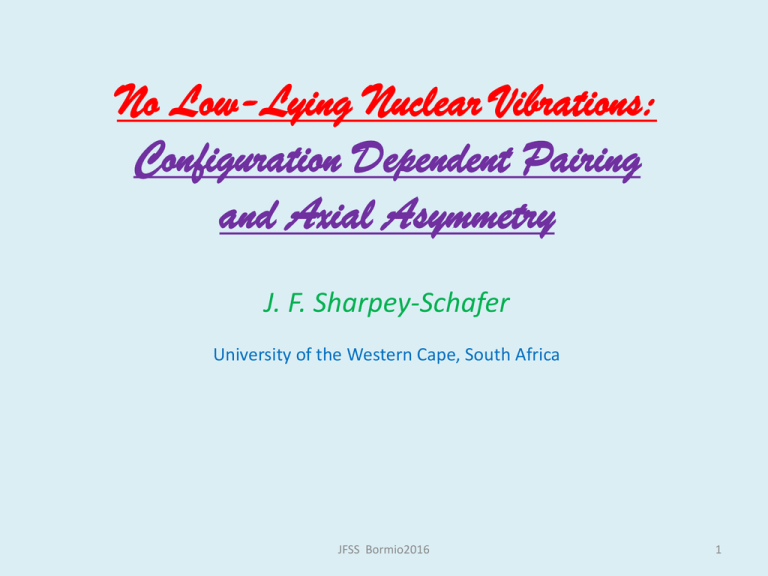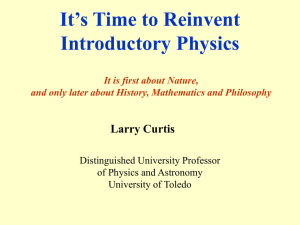K π =2 +
advertisement

No Low-Lying Nuclear Vibrations:
Configuration Dependent Pairing
and Axial Asymmetry
J. F. Sharpey-Schafer
University of the Western Cape, South Africa
JFSS Bormio2016
1
Nuclear Structure
“Standard Model”
for even-even
Deformed nuclei
Intrinsic levels in the
pairing gap assumed
to be collective
vibrations of the
nuclear shape.
Bohr & Mottelson
Vol. 2, p363
JFSS Bormio2016
2
Lord Rayleigh, Proc. Roy. Soc. of London 29, 71 (1879) App. II, Equ. (40)
frequency of vibration of a spherical liquid drop
ωλ2 =
𝜆−1 𝜆 𝜆+2 𝛾
𝜌𝑅3
WEIZÄCKER SEMI-EMPIRICAL MASS FORMULA Z. für Phys. 96 (1935) 431
Mnucleus(Z,N) = { Zmp + Nmn } – CV A + CS A2/3 + CC Z2A-1/3 + CAS (N-Z)2A-1 ± CP A-1
Leon van Dommelen, "Quantum Mechanics for Engineers
“www.eng.fsu.edu/~dommelen/quantum/style_a/nt_liqdrop.html
ωλ2 =
λ−1 λ λ+2
Cs
3
R2A mA
−
JFSS Bormio2016
2(λ−1)λ
e2 Z2
(2λ+1) 4πϵ0 R3A mp A2
3
Put R = RA A1/3 𝑅𝐴 = 1.3 𝑓𝑚 𝐶𝑠 = 18𝑀𝑒𝑉
Then for A=150, λ = 2 and using 𝐸𝑥 = ħω
𝑬𝒙 (λ = 𝟐) = 𝟐. 𝟒 𝑴𝒆𝑽
𝑬𝒙
Shell
Correction
Shell corrections make
the nucleus stiffer
putting up the
vibrational frequency
Liquid Drop
β
Moments-of-Inertia: Iirr < Iexpt < Irigid
Rayleigh, B&M assume irrotational behaviour of the nuclear “fluid”.
We would expect the experimental value to make the shape stiffer.
JFSS Bormio2016
4
40th Anniversary Of the Bohr & Mottelson Nobel Prize (1975)
Ben on his
Bike 2008
Bohr & Mottelson Vol II
“A vibrational mode of excitation is characterized by the
property that it can be repeated a large number of times. The
nth excited state of a specified mode can thus be viewed as
consisting of n individual quanta. The quanta obey Bose
statistics…” Page 330
“… but it might be expected that the zero-point oscillations in
the γ direction would be of similar magnitude as those in the β
direction. The experimentally observed E2-matrix elements for
exciting the β vibrations are comparable to those exciting the
Kπ=2+ bands….” Page 166
Ben will be 90
on 9th July 2016
“In view of the systematic occurrence of excited Kπ=2+ bands
in the spectra of strongly deformed even-even nuclei, one may
consider the possibility of describing these spectra in terms of
a rotor deviating slightly from axial symmetry.” Page 186
JFSS Bormio2016
5
01+
02+
Kπ = 2+ Bandhead
Two Neutron Transfer to 154Gd (N=90)
03+
0 4+
Shahabuddin et al; NP A340 (1980) 109
N.B. Log10 scale
JFSS Bormio2016
6
What is the │02+ > Configuration ?
۞ (t,p) & (p,t)
│02+ > is 2pn- 2hn
this gives Jπ but nothing on the orbit.
۞ Single particle transfer would give ln but
does not populate │02+ >.
In { │02+ > + neutron }, look to see
which orbit does NOT couple to │02+ >.
JFSS Bormio2016
7
K=1/2+
=2-Ω
1400
Ex
K=15/2=2+Ω
1200
(keV)
K=1/2=2-Ω
1000
155Gd
91
996 keV
Kγ=2
800
K=3/2+
{K=11/2-}
681 keV
BLOCKED
600
K=3/2400
│02+ >
[400]1/2+
[532]3/2[402]5/2+
[642]5/2+
200
[651]3/2+
0
[505]11/2-
[521]3/2-
Seen by Schmidt et al;
J. Phys. G12(1986)411
JFSS Bormio2016
in (n,γ) (d,p) & (d,t)
8
Configuration Dependent /Quadrupole Pairing
R. E. Griffin, A. D. Jackson and A. B. Volkov, Phys. Lett. 36B, 281 (1971).
Suggested that Δpp ≈ Δoo >> Δop
for Actinide Nuclei where 02+ states were observed in (p,t) that were not
pairing- or β-vibrations.
Suppose there are n prolate and n oblate degenerate levels at the Fermi Surface;
Assume that each pairing matrix element is the same for the same type -a
BUT the prolate-oblate matrix elements are very weak –εa
Then if the prolate n*n matrix is A, the oblate matrix is also A
The matrix for the total system is;
A εA
εA A
Then there are (2n-2) states with ZERO energy and 2 states with energies
E1,2 = -(1 ± ε) na
(2n-2)
02+
01+
JFSS Bormio2016
9
Configuration
Flying Fish
[505]11/2Dependent
or
orbital Quadrupole
Pairing;
Assume
Δpp≈ Δoo>> Δop
[660]1/2+
“Prolate”
R. E. Griffin, A. D. Jackson and A.
B. Volkov, Phys. Lett. 36B, 281
(1971).
W. I. van Rij and S. H. Kahana,
Phys. Rev. Lett. 28, 50 (1972).
[505]11/2“Oblate”
S. K. Abdulvagabova, S. P. Ivanova
and N. I. Pyatov, Phys. Lett. 38B,
251 (1972).
82 Neutrons
D. R. Bès, R. A. Broglia and B.
Nilsson, Phys. Lett. 40B, 338
(1972).
I. Ragnarsson and R. A. Broglia,
Nucl. Phys. A263, 315 (1976).
Prolate Deformation
First Excited 02+ states in even-even nuclei are NOT β-vibrations.
In N=88,90 nuclei they are “PAIRING ISOMERS”
JFSS Bormio2016
10
Blocking of
Pairing in
N=88-98 nuclei
JFSS Bormio2016
11
Systematics of Energies of 02+ and [505]11/2- states
for Z = 60-68 and N = 86-98
02+ SV
[505]11/2-
JFSS Bormio2016
12
ħωγ
keV
Gamma Phonon Energy (keV)
1400
Kπ=2+ γ “Vibrational” Bands
1200
1000
800
Nd
600
Sm
Gd
400
Dy
200
Er
Yb
0
86
88
90
92
94
96
98
100
Neutron Number N
Egnd state = ½ ħωβ + ħωγ
Ex (0,0,2,2) = ħωγ + ħ2/I
K = 2 Gamma Vibration Band Head Energy
JFSS Bormio2016
13
160
68Er92
Odd Spin γ-band in 160Er
Gammasphere data; Ollier et al., Phys. Rev. C83 (2011) 044309
Siyabonga
Majola et al.,
Phys Rev C91,
034330 (2015)
156
64Dy90
positive
parity
states
Lublin 2015
15
R = R0(1 + Σa2,μY2,μ + Σa3,μY3,μ + Σa4,μY4,μ + ….)
154
66Dy88
George Zimba
et al.
JFSS Bormio2016
16
“The Sympletic Shell-Model Theory of Collective States”
Cavalho, Le Blanc, Vassanji, Rowe and McGrory
Nucl Phys A452 (1986) 240
“….the β and γ degrees of freedom are not algebraically linked to
the other degrees of freedom… in any simple microscopically
recognizeable way.”
“We choose…to think of K=2 bands as triaxial rotor states,
rather than γ vibrations,….”
Lublin 2015
17
Where have all the Vibrations gone ??
Deformed Rare Earths;
Zawischa, Speth & Pal, Nucl Phys A311(1978)445
QRPA, Deformed Woods-Saxon single particle Basis,
Zero-range density dependent residual interaction.
“…it is more reasonable to identify the high-lying Kπ = 0+ and 2+ giant
quadrupole resonances with the classical β- and γ-vibrations.”
“This is due to the fact that the energies of the low-lying states are mainly
given by the details of the single-particle structure at the Fermi surface
whereas the high-lying states are of real collective nature.”
“…the microscopic wave vector of the low-lying Kπ = 0+ states is
predominantly of the pairing-vibrational type in agreement with the enhanced
two-particle transfer cross sections.”
Lublin 2015
18
Conclusions
Our Standard Model for (low energy) Nuclear Excitations is
BUST
NO vibrations, phonons, bosons etc.
BUT life is simpler, ONLY complex Deformations
If you break SPHERICAL symmetry,
you get rotational bands.
If you break AXIAL symmetry,
you get Kπ=2+ bands.
If you break REFLECTION symmetry,
you get ODD SPIN NEGATIVE PARITY bands.
If you break HEXADECAPOLE symmetry,
you get Kπ=4+ bands.
Lublin 2015
19



![Edge Ferromagnetism from Majorana Flat Bands: High-T[subscript c] Cuprate Superconductors](http://s2.studylib.net/store/data/012005636_1-94a068745a1499cc2c46da7059b10a9e-300x300.png)
![Superconducting and Ferromagnetic Phases in SrTiO[subscript 3]/LaAlO[subscript 3] Oxide Interface](http://s2.studylib.net/store/data/012070138_1-583db2fd24f741e1e45854859161a08e-300x300.png)